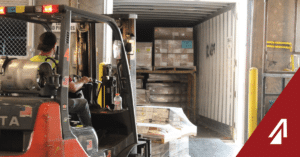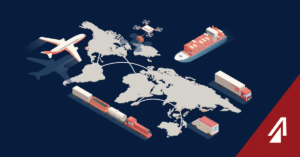The American Society of Civil Engineers produces a report card every four years for the state of the United States infrastructure (interstates, roads, bridges, etc.) and as of the most recent report, the US has a D+. American Trucking Association President, Chris Spear, said in a recent Senate testimony, “Just last week, chunks of falling concrete struck cars traveling under bridges in California and Massachusetts.” Not only is the aging US infrastructure growing more unsafe, it is also costing the trucking industry more each year in fuel, operations costs, and in exhaust emissions. These progressively worsening conditions, along with bottlenecking issues, cost the trucking industry billions each year.
What is the Problem?
There are three main issues caused by the congestion of inferior infrastructure – it costs time, it costs money, and it increases air pollution.
Costing Time
Delays from failing infrastructure or bottlenecks can cause major issues for the logistics industry. In 2016, traffic congestions caused 1.2 billion hours of delays. That equates to roughly 425,500 trucks idling for an entire year. The ATRI (American Transportation Research Institute) did a comprehensive study of one of the top bottleneck areas in the country, Atlanta’s I-285 and I-85 interchange to find out what type of impact these delays cause. Commonly known as “Spaghetti Junction,” this particular corridor ranked number one on ATRI’s Top 10 Most Congested Locations list and is a strong indicator for other congested areas as well. They found that average speeds in these congested zones drop more than nine percent during peak traffic hours. Average speed during peak times drop from 40 mph to 28 mph. These stops count against driver hours of service, delay deliveries, and prevent drivers from earning more money. In fact, the delays cost money.
Costing Money
According to UPS, their fleet being delayed as little as five minutes, costs them over $114 million per year. Many of these delays are caused by rubbernecking at accidents, congestion at freeway interchanges, and poorly timed traffic signals. With internet e-commerce booming, and speed becoming a more pressing issue, time is of the essence. Carriers cannot afford to have costly wait times – especially at major interstate intersections. Every moment of delay costs the carriers, and ultimately the customers more money.
UPS’s losses are only a fraction of the amount of money the logistics industry wastes each year. The entire industry pays nearly $74.5 billion each year in delays, damage repair from infrastructure, and fuel charges from waiting in bottlenecks and congestion. In 2016, the trucking industry consumed 6.87 billion more gallons of fuel due to congestion – an estimated $15.74 billion.
It is not just commercial drivers feeling the sting. The average American driver pays an additional $1500 per year for fuel and damages to their vehicle from infrastructure damage and congestion. AAA estimates that to be nearly $3 billion a year in damages.
Harmful Carbon Emissions
According to the EPA and others, the trucking industry is responsible for nearly half of the United States’ nitrous oxide emissions and a fourth of the greenhouse gas emissions. A staggering amount of this comes from delayed trucks, running their engines. These delayed trucks can produce approximately .5 g/min of NOx or 35.76 g/hr. Together, commercial motor vehicles make up over 442 million metric tons of harmful greenhouse gas emissions each year. Much of these emissions could be eliminated by reducing or eliminating idling.
What can be Done?
According to the American Society of Civil Engineers, approximately one of every five miles of road in the US is in bad condition (potholes, cracks, etc.) and two of every mile of urban interstate roadways are severely congested. Several sources have posted solutions to the various issues causing these delays. The Federal Highway Association (FHWA) has a few possible remedies for relieving severe congestion around “Spaghetti Junction” and other high delay areas. These include:
• Allowing motorists to use short sections of traffic-bearing shoulder lanes during peak-hours.
• Metering or closing entrance ramps during peak hours.
• Performing traffic light signal testing and perfect the existing signal timing on arterial roads.
• Increase and improve notification signs – displaying delay or diversion information.
• Implement “zippering” – a fair and smooth merging practice at congestion points.
Many Americans support changes that allow drivers to move more freely and reduce congestion, but often solutions are presented with significant tax increases. Often, citizens are unwilling to pay for these taxes. So, industry leaders, like ATA President Spear, have testified before Congress possible alternative solutions to direct taxation or moving money from general funds. Spears suggests that Congress progress with the Build America Fund, a funding effort increasing fuel prices $.20 per gallon and phased in over the course of four years. The initiative is meant to funnel more dollars toward US highways, roadways, bridges, etc. According to experts, this fund should generate as much as $340 billion dollars for infrastructure over the course of the next 10 years. Spears claims that the trucking industry is already paying nearly half of the Highway Trust Fund and that they are willing to contribute more if it meant having better roads.
The ATA published an infographic stating that most motorists feel the effects of failing infrastructure as much as the trucking industry. The average motorist pays approximately $1500 a year in fuel and repairs due to congestion. But, with the Build America Fund, they would only see a $100 fuel increase over the course of a year. Within a few years, the roadways would be repaired enough to eliminate the $1500 drivers were paying before. So, the rate increase would be a fiscally conservative option.
The state of the US infrastructure is costing the trucking industry billions. The combination of wasted time, money, and harmful environmental effects has driven truckers to call for change in regards to bottlenecks and crumbling infrastructure. Currently there are a number of solutions to these issues, but one of the strongest is posed by the ATA in the Build America Fund. Time will tell if Congress will pass the resolution and begin to save the trucking industry billions per year.



